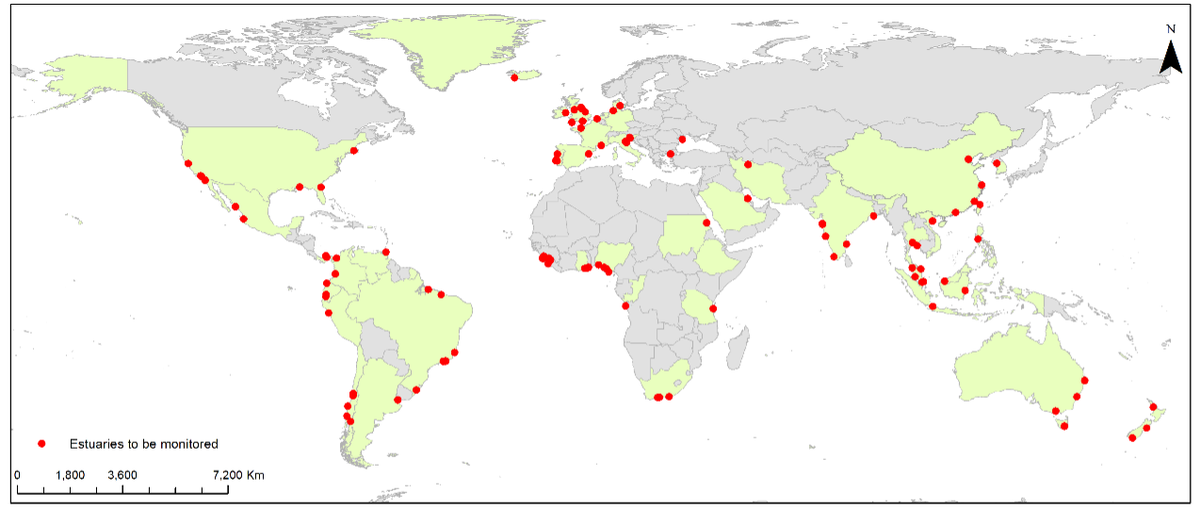Discover the Global Estuaries Monitoring Programme
A global network monitoring contaminants in estuaries worldwide
Published on 15 September 2023 | articles
Currently, more than 100,000 chemical substances are used in our daily lives and industries. Among them, 4,000 pharmaceuticals are used for preventing and treating human and animal diseases. Many of these chemicals eventually find their way into estuaries through various pathways, such as rivers, surface runoff, and partially treated wastewater discharged from treatment plants. There is a lack of information at a global level regarding the occurrence and environmental risks of different chemical contaminants in urbanized estuaries, particularly in Africa, South America, Southeast Asia, and Oceania coastal areas.
To address this issue, the Global Estuaries Monitoring (GEM) Programme aims to develop standardized methods for sampling, extracting, detecting, and quantifying priority chemical contaminants in water samples collected from major urbanized estuaries worldwide. These methods will enable a scientifically sound comparison of contamination profiles across various estuaries.
The GEM Programme is one of the first Ocean Decade Programmes endorsed by the United Nations Decade of Ocean Science for Sustainable Development (2021-2030) on June 8, 2021. The principal investigator is Prof. Kenneth Leung, Chair Professor of the Department of Chemistry and Director of the State Key Laboratory of Marine Pollution (SKLMP) at City University of Hong Kong. The project collaborates with key partners from around the world, including the University of York in the United Kingdom, Sydney Institute of Marine Science in Australia, Baylor University in the United States, National Marine Environmental Monitoring Centre, and State Key Laboratory of Marine Environmental Science at Xiamen University in China.

© GEM Programme
The study focuses on six key aspects:
Capacity Building: The GEM Programme will establish a global monitoring network for chemical contaminants in major estuaries worldwide. Researchers will receive training on how to collect environmental samples, prepare them, and conduct chemical analyses through online and/or face-to-face training sessions. Regular meetings will be held to update research progress and share findings. Stakeholders' forums will be organized to make recommendations to the United Nations and individual governments on achieving cleaner estuaries.
Standardization of Research Methods: Standardized methods for sampling, sample treatments, and analyses will ensure fair and scientifically sound comparisons of results across different study sites worldwide.
Promotion of Best Practices in Pollution Monitoring and Control: Based on the results, pollution hotspots and clean estuaries will be identified. Socioeconomic and policy analyses will be conducted to determine factors, drivers, and best practices that can lead to pollution reduction. The recommendations can be used by national and regional governments to reduce ecological risks from contaminants.
Data Sharing: All GEM programme partners will be able to share information and data generated from the programme through the GEM website. Members can upload and download information such as sampling maps and monitoring data. The results will be disseminated to corresponding governments and the United Nations.
Co-designing Research Strategies: The first phase of the project focuses on pharmaceutical residues in estuaries. Once this phase is established and running smoothly under a global network, members and end-users (e.g., policymakers, environmental authorities, fishermen communities, and other concerned groups) will collaboratively design research strategies and plan for the next phase of the GEM Programme.
Revealing the Estuary Health Status: This global effort will help reveal the latest status of chemical contaminations in major estuaries worldwide, identify pollution hotspots, and develop pollution strategies through socioeconomic and policy analyses, following best practices and tiered mitigation measures.

© GEM Programme
Over the past two years, we have been fully committed to method development and establishing connections with global collaborators. GEM has already developed and verified a robust analytical method to quantify 65 pharmaceuticals in river, estuary, and marine water samples for the GEM Programme, using only a small sample volume. This allows for economical transportation of collected samples to SKLMP in Hong Kong for chemical analysis. We have also received contributions from 140 estuaries in 65 cities across 45 countries. Currently, samples are being collected from these major urbanized estuaries globally. We expect to share our latest findings and co-design the second phase of GEM with our collaborators in the summer of 2024. At that time, partners will jointly decide on the new target pollutants for monitoring, co-design future global experiments, and seek external funding for future phases of the GEM Programme. All data analyses for the first phase of sampling are expected to be completed by the end of 2024.
The GEM Programme aims to contribute to unveiling the global pollution situation and promoting best practices to combat pollution problems, thus achieving cleaner estuaries for a better and greener future. We warmly welcome everyone to share and contribute to the GEM programme. If you wish to become a part of this global consortium, we encourage you to register now and participate in the global sampling by visiting https://gem-call-for-collaborators.questionpro.com/. Lastly, please visit and follow our website at https://www.globalestuaries.org/ to stay updated with our latest developments!
Article written by Chong Chen (University of Hong Kong), Racliffe W. S. Lai (University of Macau), Kenneth M. Y. Leung (University of Hong Kong)